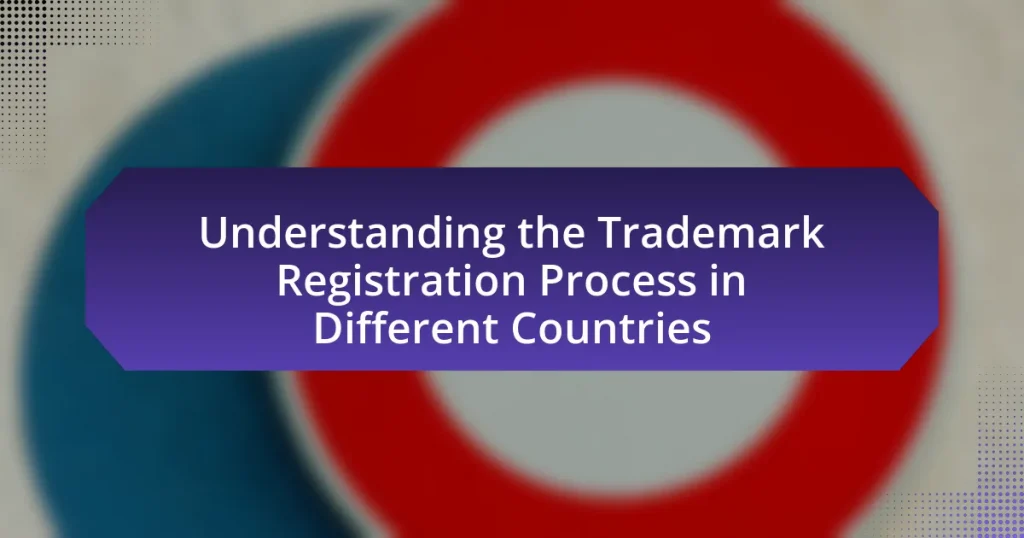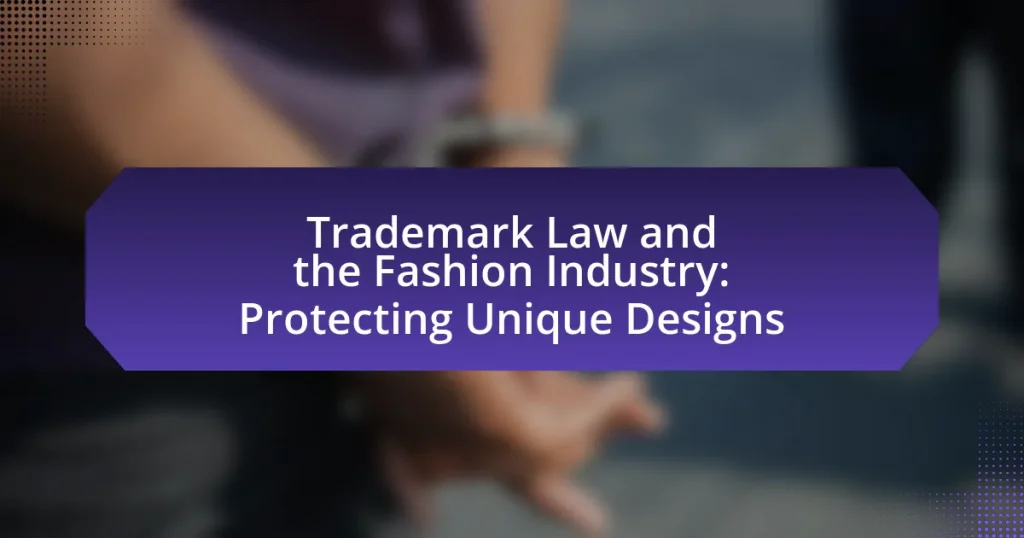The article focuses on the process of trademark opposition and cancellation, detailing the legal procedures involved in challenging the registration of a trademark. It explains the distinction between opposition, which occurs before a trademark is granted, and cancellation, which seeks to invalidate an already registered trademark. Key steps in filing an opposition, timelines, and the significance of cancellation are outlined, along with the roles of the parties involved, including the opposer and the applicant. The article also discusses the grounds for opposition and cancellation, the implications of decisions made during these processes, and best practices for navigating trademark disputes effectively.
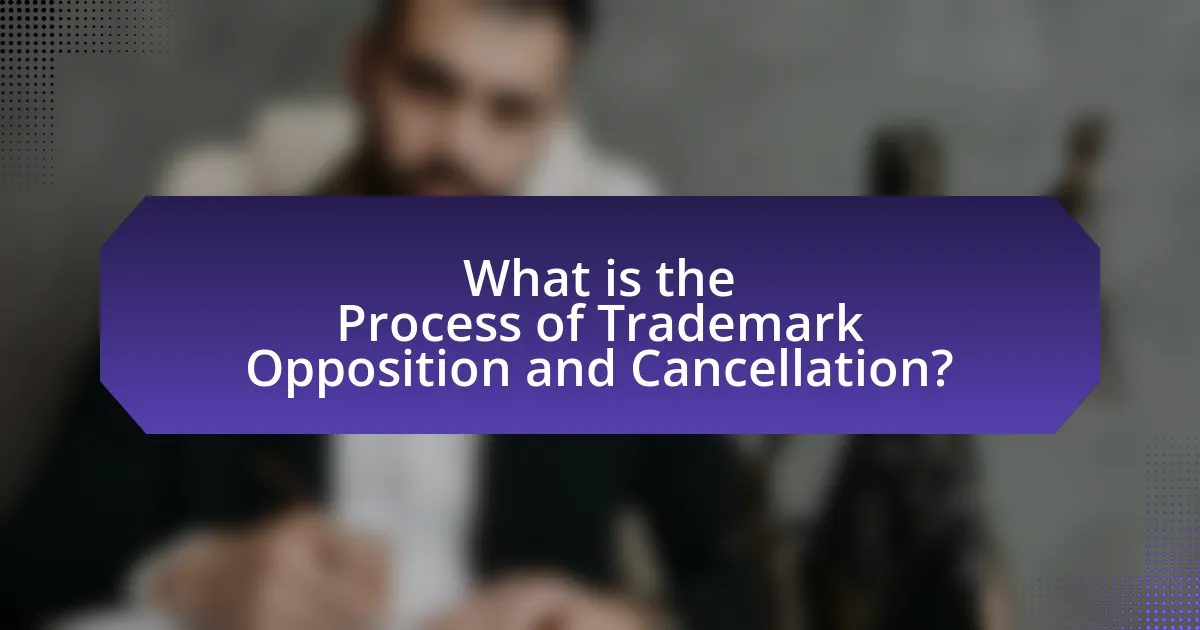
What is the Process of Trademark Opposition and Cancellation?
The process of trademark opposition and cancellation involves legal procedures to challenge the registration of a trademark. Trademark opposition occurs after a trademark application is published for opposition, allowing third parties to file an opposition if they believe the trademark will harm their interests. This typically requires submitting a notice of opposition to the relevant trademark office, detailing the grounds for opposition, such as likelihood of confusion or prior rights.
Cancellation, on the other hand, is a process initiated after a trademark has been registered, where a party seeks to invalidate the trademark registration. This is done by filing a petition for cancellation, which must also specify the grounds for cancellation, such as abandonment or non-use. Both processes are governed by specific rules and timelines set by trademark offices, such as the United States Patent and Trademark Office (USPTO), which provides a structured framework for resolving disputes over trademark rights.
How does the trademark opposition process work?
The trademark opposition process allows third parties to challenge the registration of a trademark before it is officially granted. This process typically begins after a trademark application is published in an official gazette, providing a window for interested parties to file an opposition. The opposing party must submit a notice of opposition, outlining the grounds for their challenge, which can include likelihood of confusion, descriptiveness, or prior rights.
Once the notice is filed, the applicant has the opportunity to respond. The opposition then proceeds to a discovery phase, where both parties exchange evidence and arguments. Following discovery, a trial-like proceeding occurs, often involving written briefs and possibly oral arguments before a trademark trial and appeal board. The board ultimately issues a decision, which can affirm the trademark registration, deny it, or require amendments. This process is governed by specific rules and timelines set forth by the relevant trademark office, such as the United States Patent and Trademark Office.
What are the key steps involved in filing a trademark opposition?
The key steps involved in filing a trademark opposition include identifying the grounds for opposition, preparing the notice of opposition, filing the notice with the appropriate trademark office, and serving the notice to the applicant.
First, the opposing party must determine valid grounds for opposition, such as likelihood of confusion or descriptiveness. Next, they prepare a notice of opposition that outlines the reasons for opposing the trademark application. This notice is then filed with the relevant trademark office, typically within a specified time frame after the application is published for opposition. Finally, the opposing party must serve the notice to the applicant, ensuring that all procedural requirements are met. These steps are crucial for a successful opposition process, as outlined in the United States Patent and Trademark Office (USPTO) guidelines.
What timelines should be considered during the opposition process?
During the opposition process, key timelines include the 30-day period for filing a notice of opposition after the publication of a trademark application, followed by a 40-day timeframe for the applicant to respond to the opposition. If a reply is filed, the opposition may proceed to discovery, which typically lasts for 30 days, and then to trial, where the final decision is usually rendered within six months. These timelines are established by the United States Patent and Trademark Office (USPTO) rules, ensuring a structured process for resolving disputes over trademark registrations.
What is the significance of trademark cancellation?
Trademark cancellation is significant because it serves to protect the integrity of the trademark registry by removing marks that are no longer in use or that were improperly registered. This process ensures that trademarks remain relevant and that consumers are not misled by outdated or invalid marks. For instance, the Lanham Act allows for cancellation if a trademark has not been used for three consecutive years, thereby preventing “trademark squatting” and promoting fair competition. Additionally, cancellation can help resolve disputes between businesses, allowing for the reallocation of brand names and preventing consumer confusion in the marketplace.
Why might a trademark be subject to cancellation?
A trademark may be subject to cancellation if it becomes generic, is not used in commerce, or is found to be confusingly similar to another registered trademark. Generic terms lose trademark protection because they refer to a class of products rather than a specific source. For instance, “aspirin” was once a trademark but is now generic. Additionally, if a trademark is not actively used in commerce for a continuous period, typically three years, it may be deemed abandoned, leading to cancellation. Furthermore, if a trademark is too similar to an existing trademark, it may be challenged and canceled to prevent consumer confusion, as established in cases like the 2003 ruling in the case of “E.T. v. E.T.,” where the court found that the trademarks were likely to cause confusion among consumers.
What are the grounds for filing a cancellation action?
The grounds for filing a cancellation action include the following: the trademark is not being used in commerce, the trademark was obtained fraudulently, the trademark is descriptive and lacks distinctiveness, or the trademark has become generic. Each of these grounds provides a legal basis for challenging the validity of a registered trademark. For instance, if a trademark has not been used in commerce for three consecutive years, it may be deemed abandoned, which supports a cancellation claim. Additionally, if evidence shows that the trademark was registered based on false information, this can also justify cancellation.
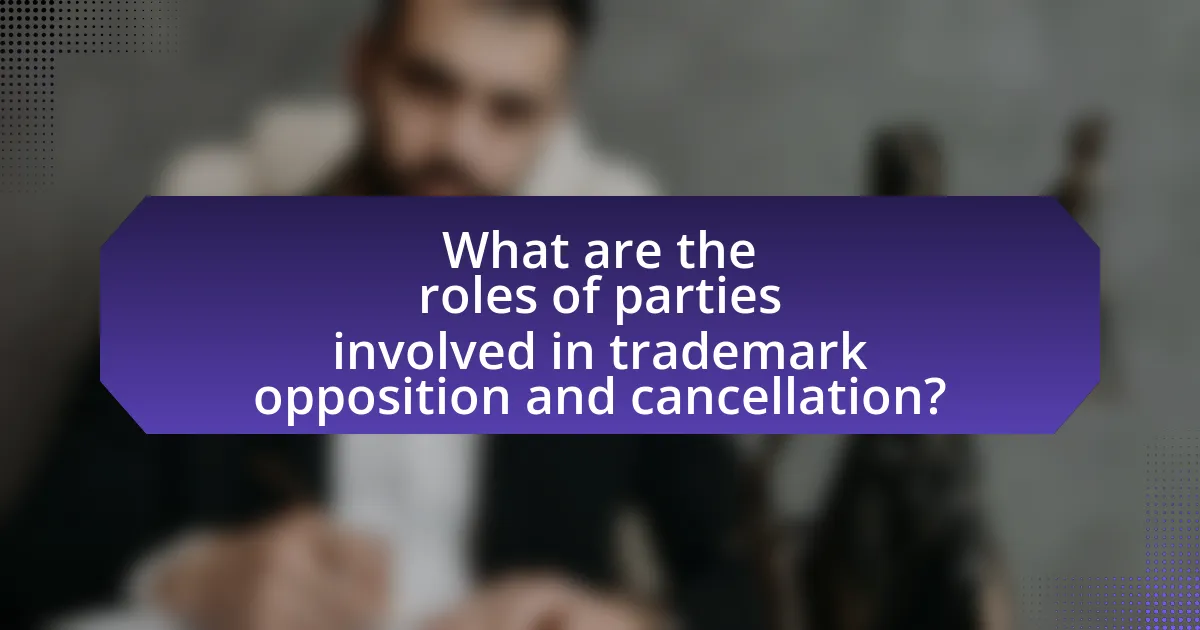
What are the roles of parties involved in trademark opposition and cancellation?
In trademark opposition and cancellation, the primary parties involved are the opposer and the applicant or registrant. The opposer is the party that challenges the registration of a trademark, asserting that the mark should not be granted due to potential confusion with their own trademark or other legal grounds. The applicant or registrant is the party seeking to register or maintain the trademark, defending its right to do so against the opposer’s claims.
The opposer must provide evidence supporting their claims, such as demonstrating prior use of a similar mark or showing that the mark is likely to cause confusion among consumers. The applicant or registrant, on the other hand, must counter these claims by presenting arguments and evidence that justify the registration of their trademark, such as proving distinctiveness or lack of confusion.
This dynamic establishes a legal framework where both parties present their cases before a trademark office or court, ultimately leading to a decision on the validity of the trademark registration.
Who can file a trademark opposition?
Any party that believes they may be harmed by the registration of a trademark can file a trademark opposition. This includes individuals, businesses, or organizations that have a legitimate interest in the trademark’s use or that may be affected by its registration. The basis for filing an opposition typically involves claims of likelihood of confusion with an existing trademark, dilution, or other grounds as specified in trademark law. The United States Patent and Trademark Office (USPTO) allows oppositions to be filed during a specific period after a trademark application is published for opposition, ensuring that interested parties have the opportunity to contest the registration.
What qualifications must an opposer have?
An opposer must have a legitimate interest in the trademark being opposed, typically demonstrated by prior use of a similar mark or a likelihood of confusion. This requirement ensures that the opposer is directly affected by the registration of the trademark in question. For instance, under U.S. law, the opposer must show that they would be harmed by the registration, which is often established through evidence of existing trademark rights or a strong business interest in the market.
How does the role of the trademark owner differ in this process?
The role of the trademark owner in the process of trademark opposition and cancellation is primarily as the party defending their trademark rights. Trademark owners must actively monitor and respond to opposition filings, providing evidence to support the validity of their trademark and countering claims made by opponents. This responsibility includes gathering documentation, presenting arguments, and potentially engaging in negotiations or litigation to protect their intellectual property. The trademark owner’s proactive involvement is crucial, as failure to adequately defend their trademark can result in loss of rights or cancellation of the trademark registration.
What legal representatives are typically involved?
In the process of trademark opposition and cancellation, the legal representatives typically involved are trademark attorneys and intellectual property lawyers. Trademark attorneys specialize in the registration and protection of trademarks, guiding clients through the opposition process and representing them before the Trademark Trial and Appeal Board (TTAB). Intellectual property lawyers may also be involved, providing broader legal advice on trademark rights and strategies for cancellation proceedings. Their expertise ensures compliance with legal standards and effective representation in disputes, which is crucial given that the TTAB handles thousands of cases annually, emphasizing the need for knowledgeable legal representation.
What is the role of an attorney in trademark opposition and cancellation?
An attorney plays a crucial role in trademark opposition and cancellation by providing legal representation and guidance throughout the process. They assist clients in filing opposition notices against trademark applications that may infringe on their existing trademarks, ensuring compliance with the legal requirements set by the United States Patent and Trademark Office (USPTO). Additionally, attorneys help in preparing and submitting cancellation petitions to challenge the validity of registered trademarks, often based on grounds such as abandonment or likelihood of confusion. Their expertise in trademark law enables them to effectively argue cases before the Trademark Trial and Appeal Board (TTAB), increasing the likelihood of a favorable outcome for their clients.
How can trademark professionals assist in navigating the process?
Trademark professionals assist in navigating the trademark opposition and cancellation process by providing expert guidance on legal requirements and strategies. They analyze the trademark application and opposition filings to identify potential issues, ensuring compliance with relevant laws and regulations. Additionally, trademark professionals conduct comprehensive searches to assess the likelihood of success in opposition cases, which is crucial for informed decision-making. Their expertise includes drafting and filing necessary documents, representing clients in hearings, and negotiating settlements, thereby streamlining the process and increasing the chances of a favorable outcome.
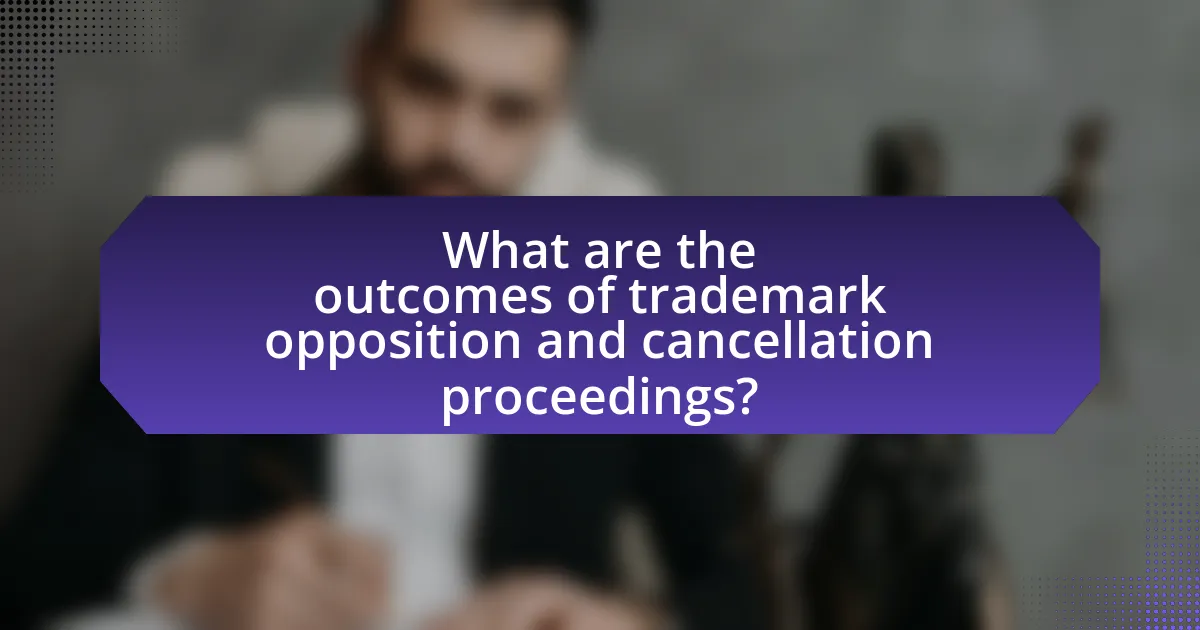
What are the outcomes of trademark opposition and cancellation proceedings?
The outcomes of trademark opposition and cancellation proceedings can result in either the maintenance or the cancellation of a trademark registration. In opposition proceedings, if the opposing party successfully proves that the trademark should not be registered due to likelihood of confusion or other grounds, the application may be denied. Conversely, if the applicant successfully defends against the opposition, the trademark will be registered. In cancellation proceedings, if the petitioner demonstrates valid grounds for cancellation, such as abandonment or non-use, the trademark registration may be canceled. These outcomes are governed by trademark law and can significantly impact the rights of trademark owners and their ability to enforce their marks in the marketplace.
What are the possible results of a trademark opposition?
The possible results of a trademark opposition include the rejection of the trademark application, the approval of the trademark application, or a settlement between the parties involved. When an opposition is filed, the trademark office reviews the evidence and arguments presented by both the opposing party and the applicant. If the opposition is successful, the trademark application may be denied, preventing the applicant from registering the mark. Conversely, if the opposition fails, the trademark may be granted registration. Additionally, parties may reach a settlement, which could involve the applicant amending their application or agreeing to coexistence terms. These outcomes are determined based on the merits of the case and the legal arguments presented.
How can a successful opposition affect the trademark application?
A successful opposition can lead to the rejection of a trademark application. When an opposition is filed and deemed successful, it indicates that the opposing party has provided sufficient evidence to demonstrate that the trademark in question conflicts with their existing rights or could cause consumer confusion. This can result in the trademark office denying the application, thereby preventing the applicant from securing trademark protection. Historical data shows that in the United States, approximately 30% of trademark applications face opposition, and a significant portion of those oppositions result in the application being withdrawn or denied.
What happens if the opposition is unsuccessful?
If the opposition is unsuccessful, the trademark application proceeds to registration. The unsuccessful opposition means that the opposing party did not provide sufficient evidence or legal grounds to challenge the trademark’s validity. Consequently, the trademark office will grant the application, allowing the applicant to secure exclusive rights to the trademark. This process is governed by trademark laws, which stipulate that if no valid opposition is established, the application is typically approved, as seen in various trademark cases where oppositions failed due to lack of evidence or legal standing.
What are the implications of a trademark cancellation decision?
A trademark cancellation decision results in the removal of a trademark’s legal protection, allowing others to use the previously protected mark without infringement concerns. This decision can lead to increased competition in the market, as competitors can freely use the name or logo that was once exclusive to the trademark holder. Additionally, the cancellation can diminish the brand’s value and reputation, as consumers may become confused about the source of goods or services associated with the mark. Historical cases, such as the cancellation of the “Coca-Cola” trademark in certain jurisdictions, illustrate how such decisions can impact brand identity and market dynamics.
How does cancellation impact the trademark owner’s rights?
Cancellation of a trademark directly impacts the trademark owner’s rights by nullifying their exclusive rights to use the mark in commerce. When a trademark is canceled, the owner loses the legal protections that prevent others from using a similar mark, which can lead to increased competition and potential market confusion. This loss of exclusivity can diminish the brand’s value and reputation, as the owner can no longer enforce their rights against infringers. Additionally, the cancellation process often involves a legal proceeding that can be costly and time-consuming, further affecting the owner’s ability to maintain their trademark rights.
What recourse does a trademark owner have after cancellation?
A trademark owner has the recourse to appeal the cancellation decision through the Trademark Trial and Appeal Board (TTAB) or to seek judicial review in a federal court. The owner can file a notice of appeal within a specified timeframe, typically 30 days from the cancellation decision. This process allows the trademark owner to challenge the grounds for cancellation and present evidence supporting the validity of their trademark rights. The TTAB’s decisions can be further appealed to the U.S. Court of Appeals for the Federal Circuit, providing an additional layer of legal recourse.
What best practices should be followed during trademark opposition and cancellation?
During trademark opposition and cancellation, it is essential to conduct thorough research on the trademark in question, including its registration details and potential conflicts. This foundational step ensures that the opposition or cancellation is based on valid grounds, such as likelihood of confusion or non-use.
Additionally, timely filing of the opposition or cancellation notice is crucial, as deadlines are strictly enforced by trademark offices. Properly drafting the notice with clear and concise arguments strengthens the case, while supporting evidence, such as market surveys or expert opinions, can substantiate claims.
Engaging legal counsel experienced in trademark law can enhance the effectiveness of the process, as they can navigate complex legal requirements and represent the interests effectively. Finally, maintaining open communication with the opposing party may lead to settlement opportunities, potentially avoiding lengthy litigation.
How can parties prepare effectively for opposition proceedings?
Parties can prepare effectively for opposition proceedings by conducting thorough research on the trademark in question and gathering relevant evidence to support their position. This preparation involves analyzing the opposing party’s trademark application, identifying potential grounds for opposition, and collecting documentation such as prior registrations, usage evidence, and consumer surveys that demonstrate the likelihood of confusion. Additionally, parties should develop a clear strategy outlining their arguments and potential counterarguments, ensuring they are well-versed in trademark law and procedural rules governing the opposition process. This approach is validated by the fact that successful oppositions often hinge on the strength of the evidence presented and the clarity of the arguments made.
What common mistakes should be avoided in the cancellation process?
Common mistakes to avoid in the cancellation process include failing to meet deadlines, not providing sufficient evidence, and neglecting to follow procedural rules. Meeting deadlines is crucial, as missing them can result in automatic dismissal of the cancellation request. Providing insufficient evidence undermines the case, as the burden of proof lies with the party seeking cancellation. Additionally, neglecting procedural rules, such as proper filing and notification requirements, can lead to complications or rejection of the cancellation. These mistakes can significantly hinder the effectiveness of the cancellation process.

